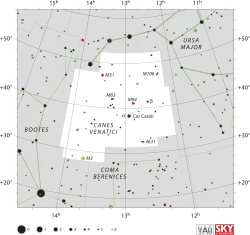HAT-P-36
HAT-P-36, also referred to as Tuiren[4] is a 12th magnitude G-type main-sequence star estimated to be approximately 958 light-years away from Earth[2] in the constellation Canes Venatici. HAT-P-36 is too faint to be seen with the naked eye, but it is possible to view it with binoculars or a small telescope. In 2012 a hot Jupiter-type exoplanet was discovered orbiting HAT-P-36 with an orbital period of about 1.3 Earth days.[5] In December 2019, HAT-P-36 was named Tuiren and its planetary companion, HAT-P-36b, was named Bran as a result of Ireland's contribution to the 2019 NameExoWorlds campaign.[6] Bran has a mass approximately 1.8 times that of Jupiter and a radius 1.2 times larger.

| |
| Observation data Epoch J2000.0 Equinox J2000.0 | |
|---|---|
| Constellation | Canes Venatici[1] |
| Right ascension | 12h 33m 03.9061s[2] |
| Declination | +44° 54′ 55.196″[2] |
| Apparent magnitude (V) | 12.26 |
| Characteristics | |
| Spectral type | G |
| Astrometry | |
| Radial velocity (Rv) | −16.434 km/s |
| Proper motion (μ) | RA: −11.622(8) mas/yr[2] Dec.: 8.138(10) mas/yr[2] |
| Parallax (π) | 3.4055 ± 0.0110 mas[2] |
| Distance | 958 ± 3 ly (293.6 ± 0.9 pc) |
| Details | |
| Mass | 1.022 ± 0.049 M☉ |
| Radius | 1.096 ± 0.056 R☉ |
| Temperature | 5580 ± 100.0 K |
| Metallicity [Fe/H] | 0.26 ± 0.08 dex |
| Age | 6.6 ± 1.8 Gyr |
| Other designations | |
| Database references | |
| SIMBAD | data |
Etymology
_in_Aladin_Lite_(cropped).png.webp)
HAT-P-36 and its planet are named after characters from The Birth of Bran, a story in the book Irish Fairy Tales by James Stephens. The book is a re-telling of various stories from Irish folklore. Tuiren was the aunt of the mythical hero Fionn mac Cumhaill and was turned into a hound by the fairy Uchtdealbh after Tuiren married her husband. Bran and Sceólan were the two puppies mothered by Tuiren while she was a dog. They were cousins of Fionn mac Cumhaill. The names were proposed by John Murphy, a teacher at Regina Mundi College, Cork.[8]
Planets
| Companion (in order from star) |
Mass | Semimajor axis (AU) |
Orbital period (days) |
Eccentricity | Inclination | Radius |
|---|---|---|---|---|---|---|
| b (Bran) | ≥1.832±0.099 MJ | 0.0238±0.0004 | 1.327347±0.000003 | 0.063±0.032 | 86±1.3° | 1.264±0.071 RJ |
HAT-P-36b (Bran) was discovered in 2012 by the HATNet Project using the transit method.[5] A search for transit timing variation did not result in detection of additional planets in the system as at 2021.[10] Surprisingly, a planetary orbital period increase by 0.014 seconds per year was detected by 2021.[11]
| Jupiter | HAT-P-36b (Bran) |
|---|---|
 |
 |
References
- Roman, Nancy G. (1987). "Identification of a Constellation From a Position". Publications of the Astronomical Society of the Pacific. 99 (617): 695–699. Bibcode:1987PASP...99..695R. doi:10.1086/132034. Vizier query form
- Vallenari, A.; et al. (Gaia collaboration) (2023). "Gaia Data Release 3. Summary of the content and survey properties". Astronomy and Astrophysics. 674: A1. arXiv:2208.00211. Bibcode:2023A&A...674A...1G. doi:10.1051/0004-6361/202243940. S2CID 244398875. Gaia DR3 record for this source at VizieR.
- "HAT-P-36". SIMBAD. Centre de données astronomiques de Strasbourg. Retrieved 2023-02-23.
- "IAU100 NameExoWorlds Approved Names" (PDF). NameExoWorlds. International Astronomical Union. Retrieved 24 July 2020.
- "HAT-P-36". Open Exoplanet Catalogue. Retrieved 24 July 2020.
- Smith, Niall (29 September 2019). "Sky Matters: Ireland has the chance to name a star and a planet - any ideas?". Irish Examiner. Retrieved 24 July 2020.
- "TYC 3020-2195-1". Centre de Données astronomiques de Strasbourg. SIMBAD. Retrieved 24 July 2020.
- Gorey, Colm (18 December 2019). "Cork teacher names exoplanet and star after Irish mythical dogs". Silicon Republic. Retrieved 24 July 2020.
- "Planet HAT-P-36 b". Extrasolar Planets Encyclopaedia. Retrieved 24 July 2020.
- Sonbas, E.; Karaman, N.; Özdönmez, A.; Er, H.; Dhuga, K. S.; Göğüş, E.; Nasiroglu, I.; Zejmo, M. (2022), "Probing Transit Timing Variations of three hot Jupiters: HATP-36b, HATP-56b, and WASP-52b", Monthly Notices of the Royal Astronomical Society, 509 (4): 5102–5116, arXiv:2111.05220, doi:10.1093/mnras/stab3270
- Yalçınkaya, S.; Baştürk, Ö.; ElHelweh, F.; Esmer, E.M.; Yörükoğlu, O.; Yılmaz, M.; Şenavcı, H.V.; Kılıçoğlu, T.; Selam, S.O. (2021), "Analysis of the Most Precise Light Curves of HAT-P-36 Detrended from Spot Signals", Acta Astronomica, 71 (3), arXiv:2111.11531, doi:10.32023/0001-5237/71.3.3, S2CID 244488216